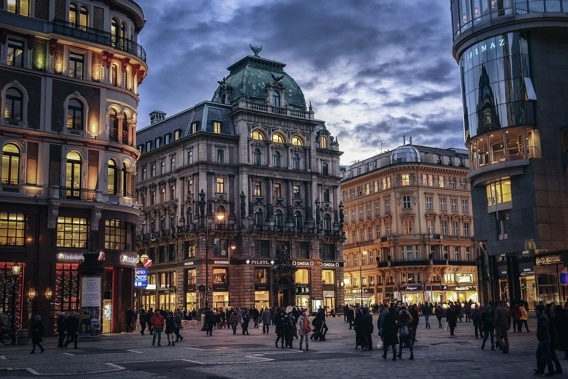
You could spill vast rivers of blue Danube ink try to encapsulate the enduring brilliance of Vienna and all that it has lavished on the world. It’s the city that vaulted Mozart, Beethoven, Haydn, Strauss and his waltz into the world’s consciousness. The city that unleashed the genius of Freud, published the world’s first newspaper, conceived the delicious Torte, and was the powerbase for the imperial Hapsburgs. Vienna remains a city of culture, class and beauty; of churches, castles and concert halls.
I recently returned to the Austrian capital as part of Trafalgar’s 10 day Imperial Europe tour, which serves up a superbly curated string of authentic encounters in some seriously decorated destinations. As my Trafalgar travel director Kate remarked, “Vienna elevated coffee onto the highest pedestal.” And as a major caffeine fiend, Vienna’s revered coffee houses pleasingly loomed large on the agenda.
It’s ironic that the rampaging Ottoman Turks, who desperately tried to seize strategically important Vienna, inadvertently sowed the seeds for one of its great legacies. Defeated Turkish forces left behind many bags of coffee beans, giving rise to the great cafe society. Although as I discovered in Vienna, the locals who discovered the bags weren’t exactly sure what to do with them. At first, they thought the beans should be added to soup. It was only after they pumped some imprisoned Turkish soldiers for knowledge, that Vienna’s long love affair with coffee was first unleashed.
Four centuries later, the classic coffee houses, resplendent with plush velvet seats, Thonet chairs, and marble tables remain crucial to the city’s soul and social pulse. Add to that, the more than 2000 ‘modern’ cafes in Vienna. During our Trafalgar walkabout, local specialist guide Claudia mentioned the city centre still boasts a whopping 100 coffee houses. And we ventured to Cafe Demel. Located a stone’s throw from the creamy curved splendour of Hofburg Palace and the constant clop-clop-clop of the horse and carriage trade, this Kohlmarkt café is widely considered by Vienna’s coffee and cake connoisseurs as an institution.
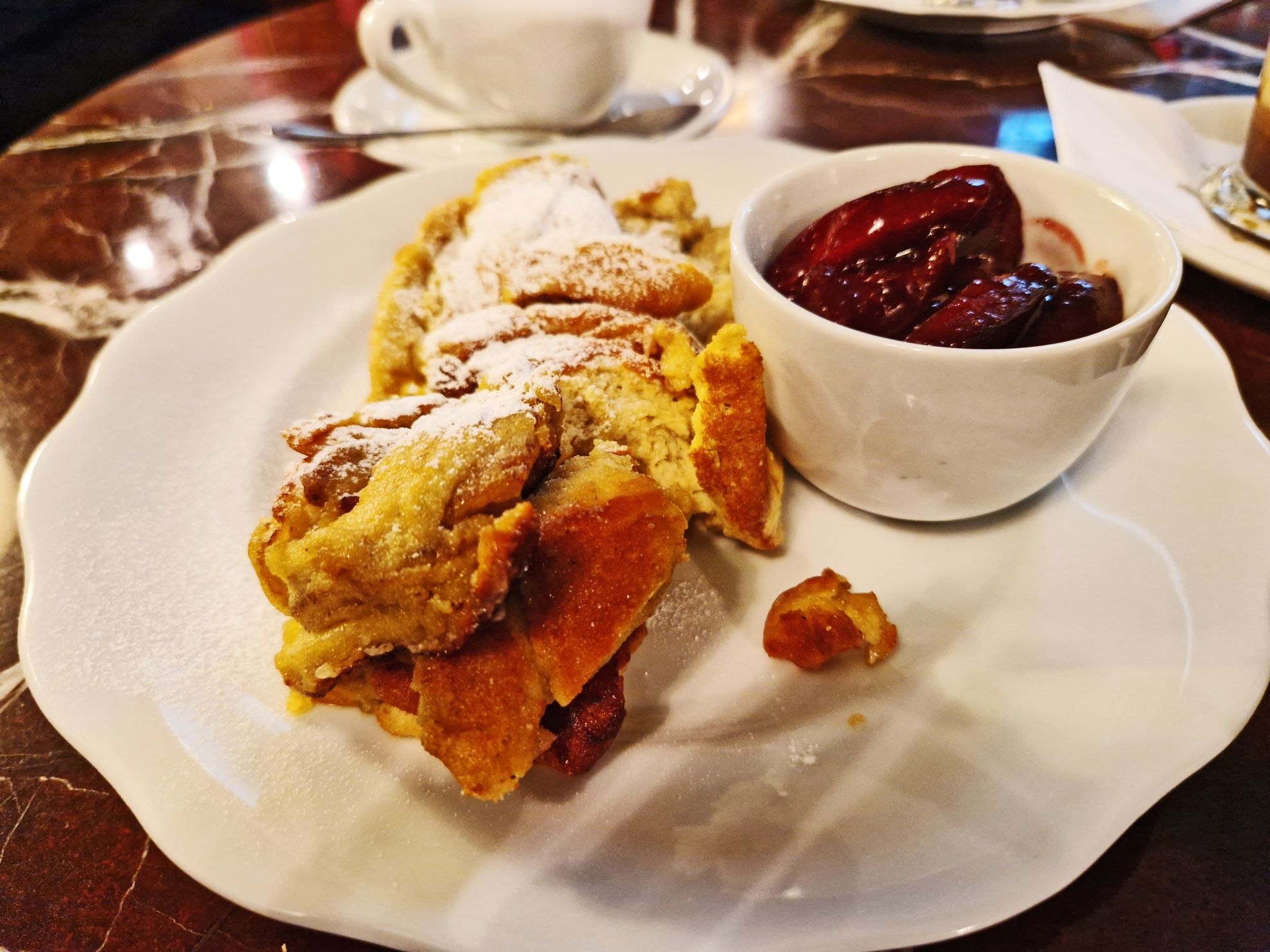 Kaiserschmarrn at Cafe Demel. Photo / Supplied
Kaiserschmarrn at Cafe Demel. Photo / Supplied
The old-school pastry shop and confectioner was established in 1786 and still bears the title of a Purveyor to the Imperial and Royal Court. The café you see today, decorated in Rococo style and complemented by Regency furnishings, was established a century later, shortly after Franz Josef I pulled down the city walls and developed the famous Ring Strasse, which circles the heart of the city, edged by showpiece architecture like the Austrian Parliament, inspired by the Parthenon in Athens.
Café Demel is staffed by efficient white-aproned waitresses, order up a Wiener Melange, which is an expresso with steamed milk and foam. Or go full fancy with a Fiaker Coffee – large espresso with cherry schnapps & whipped cream. A local sweet treat at Demel that I quickly succumbed to was buchtein: fluffy yeast dumplings stuffed with apricot jam and served with hot vanilla sauce. They’re also a go-to for Kaiserschmarrn with stewed plums. Kaiserschmarrn is best described as fluffy shredded pancakes, which takes its name from the Hapsburg emperor Franz Joseph I, who was very fond of them. Claudia mentioned that Vienna's oldest coffee house is Cafe Frauenhuber, which celebrated its 200th birthday last year.
Originally a restaurant from the 18th century, it is claimed that Wolfgang Amadeus Mozart and Ludwig van Beethoven performed table music here. Café Central is another venerable establishment, fawned over by poets and philosophers since the 1870s. I also opted for the more contemporary Viennese offering at Café Aida, bedecked in a Barbie pink glow. I ordered up an Einspanner – large espresso with whipped cream in the glass. The counter cabinet titillates with the most dazzling display of tortes, including the famous Sacher Torte (filled with apricot jam), which was conceived in the nearby Sacher Hotel. But I opted to gorge myself on a large bowl of apple strudel bathed in hot vanilla sauce. It was decadently, indecently good.
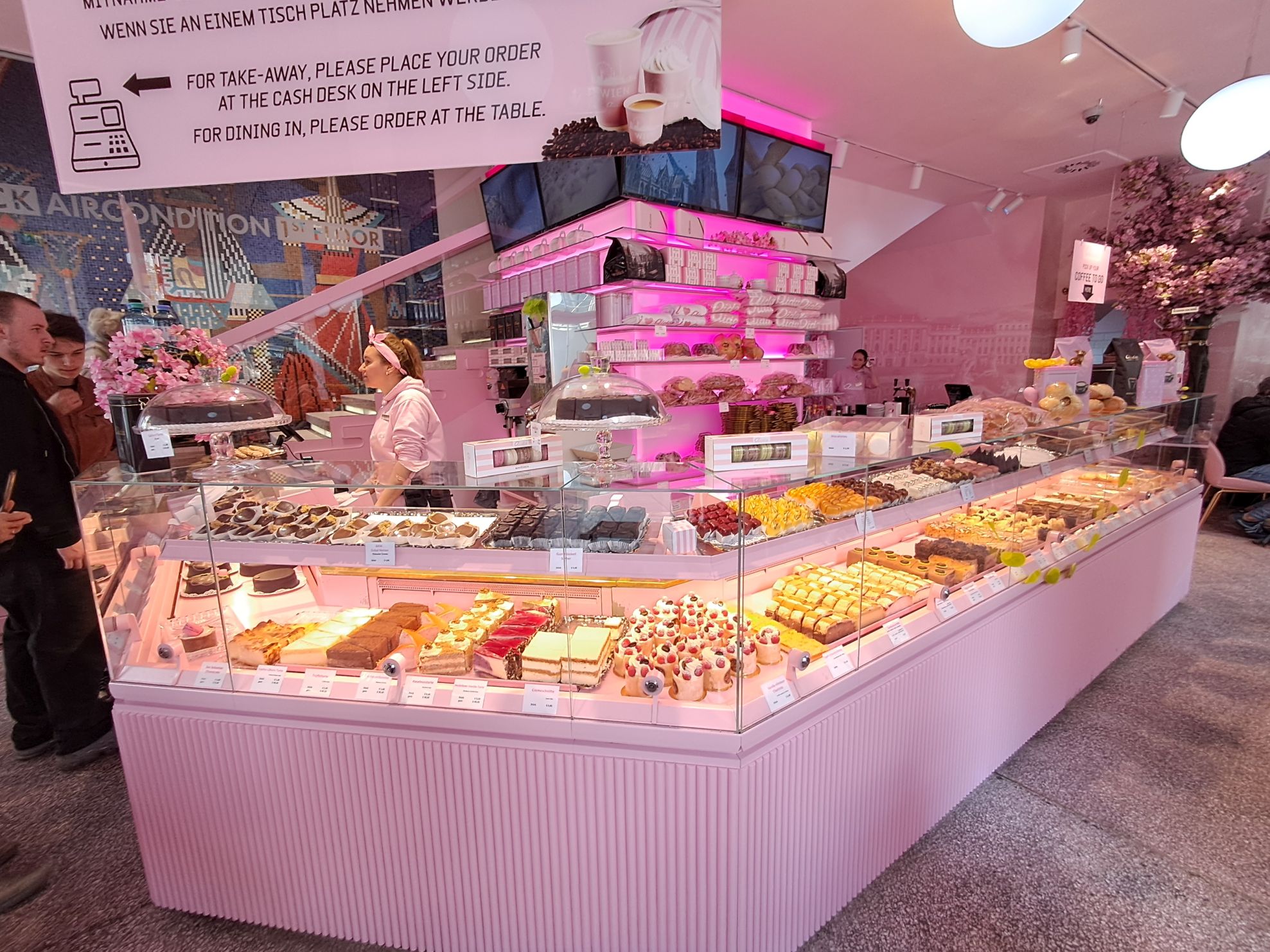 Cabinet temptations at Cafe Aida. Photo / Mike Yardley
Cabinet temptations at Cafe Aida. Photo / Mike Yardley
More signature bites? The runaway icon is Wiener Schnitzel, which traditionally, is a cutlet of veal pounded thin by a meat tenderiser, then dipped in flour, egg and breadcrumbs, and fried until golden. If a restaurant sells Wiener Schnitzel made from some other meat than veal, then they have to say so. Veal is from young calves, an incredibly tender meat and milder than beef. Given its exorbitant price, the cheaper alternative is pork, beef or chicken schnitzel. Don’t be surprised to get a near pizza-sized piece of Schnitzel deposited on your plate with the only vegetable in sight a sprig of parsley as a garnish.
Most locals will order a side dish of potato salad. Just behind St Stephen’s Cathedral, in the maze of old town lanes, stake out the 120 year old Figlmuller Restaurant, which bills itself as the home of the original Wiener Schnitzel – although they didn’t create it. They also do a pork version, Figlmuller Schniztel, which is so big, it will protrude over your dinner plate. The quintessential street food to wrap your lips around is leberkase, which is kind of like a slice of meatloaf inside a crusty bun. The meat is typically a combination of finely chopped pork, bacon and beef. Wild boar is popular at Christmas. But resembling a pinkish pate, it is remarkably tasty and best served heated.
 Wiener Schnitzel at Figlmuller. Photo / Supplied
Wiener Schnitzel at Figlmuller. Photo / Supplied
Shopping, noshing and lingering is a most alluring pursuit in Kohlmarkt, which is Vienna’s luxury retail row. A slew of high-end stores flank the pedestrianised cobblestones – and not just the usual suspects like Gucci and Prada, but one-off speciality stores. From Kohlmarkt, head to the golden retail sweep of Karntner Strasse. Heavily pedestrianised, the only notable rivals to the frenetic foot traffic is the clop-clop-clop of the horse and carriage brigade. Vienna’s abiding affection with this romantic form of transport stretches back many centuries, and the fiaker (as the locals call a carriage-rider) is a very prestigious job.
The central terminus for the horse and carriage trade is situated outside Vienna’s august Gothic cathedral, St. Stephen’s. Dating back to the 13th century, the cathedral’s soaring spires dominate the skyline. “The Steffl” as it’s informally called, was severely damaged by bombing raids during World War II, and its rebuilding was a potent symbol of hope as Austria emerged from the ashes of conflict. Claudia also pointed out a sublime perch over the city centre, the Sky Garden which adorns the roof top of Steffl department store. The panoramic glass elevator ride up to the roof is worth the visit alone.
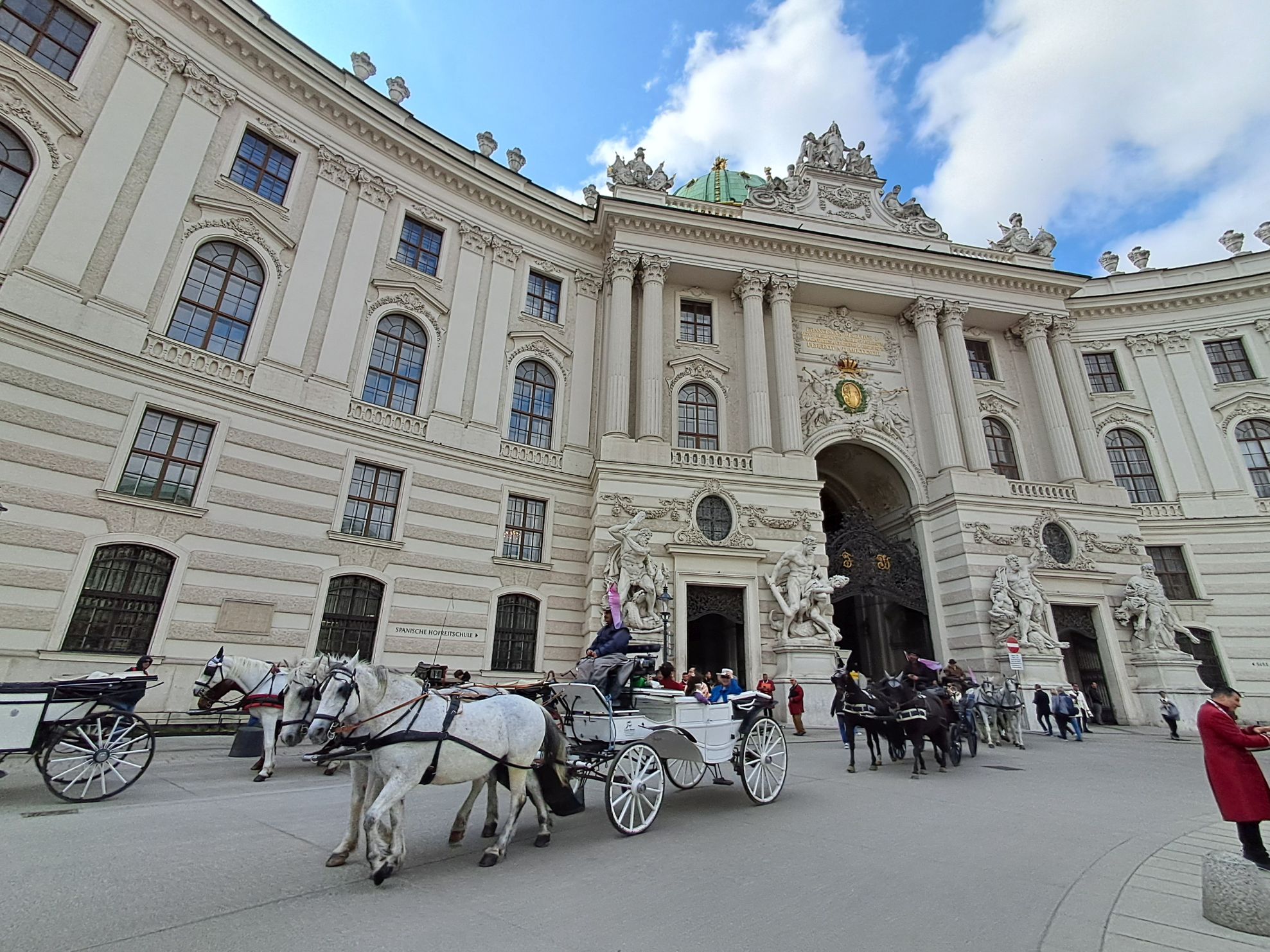 Carriage rides by the Hofburg. Photo / Mike Yardley
Carriage rides by the Hofburg. Photo / Mike Yardley
At the southern end of Karntner Strasse, the Vienna State Opera House is unquestionably one of the world’s most acclaimed concert halls. The masterworks of Mozart, Beethoven and company continue to be performed every week at the opera house, which also offers daily tours. The Renaissance-style opera house has a busy roster of magical evenings of stirring classical music. The city swells with music but it’s a notable year for Strauss fans because Vienna is lustily celebrating the 200th birthday of Johann Strauss II, the King of Waltz.
His most famous piece is the Blue Danube and there’s a year-long roster of celebration concerts and events in Vienna. He was the Harry Styles of his day, a wildly idolised popstar, and quite the womaniser. Some historians claim he was engaged 13 times. Alongside the Mozart statue in the Royal Gardens, definitely check-out the freshly spruced-up golden statue of Strauss in Stadtpark, just off the Ring Strasse, where regular open-air concerts will be staged.
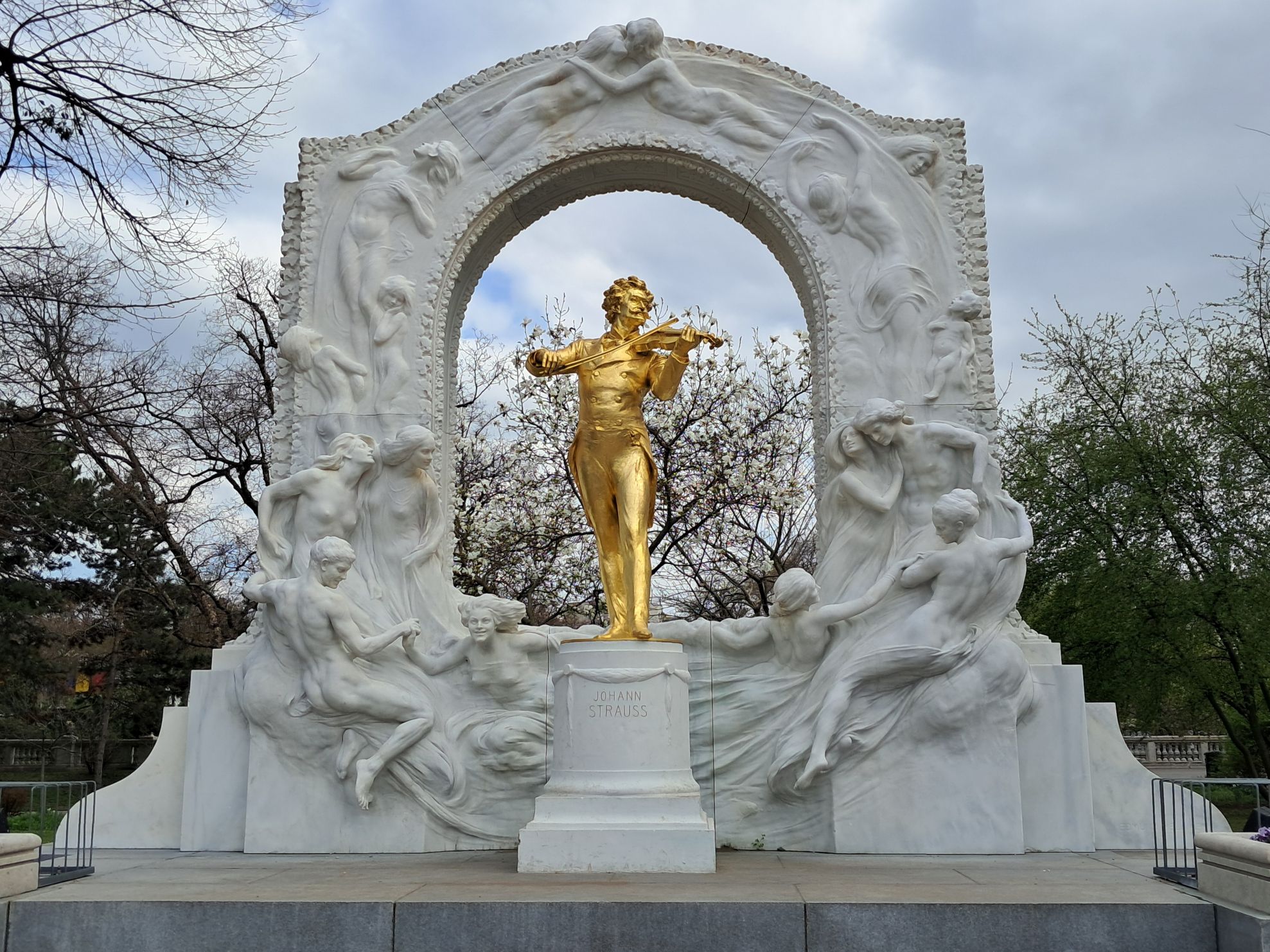 John Strauss monument. Photo / Mike Yardley
John Strauss monument. Photo / Mike Yardley
With a mix of art exhibitions, palatial interiors, striking sculpture and manicured lawns, the Belvedere Palace remains my favourite regal spot in Vienna. Constructed by Prince Eugen to celebrate the defeat of the invading Ottoman Turks in 1683, it is now one of Vienna’s most popular weekend haunts. The locals love flocking here to kick-back. The French-style formal gardens are replete with fountains and topiary, however it’s the classic statuary, complete with Greek mythological figures, that are particularly eye-catching. The Belvedere also houses the world’s largest collection of oil paintings by the renowned Austrian painter, Gustav Klimt, culminating with his most acclaimed work, The Kiss, which is a major crowd-puller.
The former Imperial Palace of the Hapsburgs, the Hofburg, is still home base for the Vienna Boys’ Choir in the Royal Chapel, and the Spanish Riding School. The elegant white Lipizzaner stallions of the Spanish Riding School were regularly used by the Hapsburgs for military equestrian pursuits, imperial celebrations and entertainment. They been a Viennese staple for over 400 years.
Probably most famous boys’ choir in the world, which now also includes girls, the choir has been going strong for over 500 years. On Sundays, the choir performs as part of traditional mass at the Hofburg Chapel, which is the easiest way of experiencing them in Vienna. Although you’ll only hear them during the mass, following the service, they appear in front of the altar to perform a small number of works for the public. An optional tour with Trafalgar gave us preferential access upon opening to Schonbrunn Palace. Inspired by Versailles, this bling-bling behemoth served as the Habsburg emperors' summer residence, with elaborate gardens and a staggering 1400 rooms.
Getting a jump on the queues, particularly at Austria’s most-visited attraction, is an undeniable advantage travelling with Trafalgar delivers. The city is ringed by the Vienna Woods on three sides and another superb optional tour with Trafalgar zips you up to Kahlenberg Mountain in the Vienna Woods, which was the epic site of the Battle of Vienna. The city had been besieged by the Ottoman Empire for two months, but the Hapsburg Empire, aided by many fellow Christian rulers, finally defeated the invading Turks here in 1683, abruptly ending their march across Europe. The wooded hills have been preserved for centuries and are credited for maintaining Vienna’s stature as having Europe’s best urban air quality.
For some cheap thrills to top off your waltz through Vienna, make a date with Prater, one of the oldest amusement parks in the world. Ever since 1766 when Prater first opened to the public, it has been a nursery for many of the world’s formative carnival rides, including the world’s first ghost train. Its enduring landmark attraction is the Riesenrad (Giant Ferris wheel), which was built in 1897 to celebrate the Golden Jubilee of Emperor Franz Josef I. Still considered the oldest operating ferris wheel in the world, it was severely damaged in WWII, destroying half of the cabins. Just as James Bond did in The Living Daylights, take a ride in one of the 15 meticulously restored cabins for more enchanting rooftop views and fairground fun. No martinis, included.
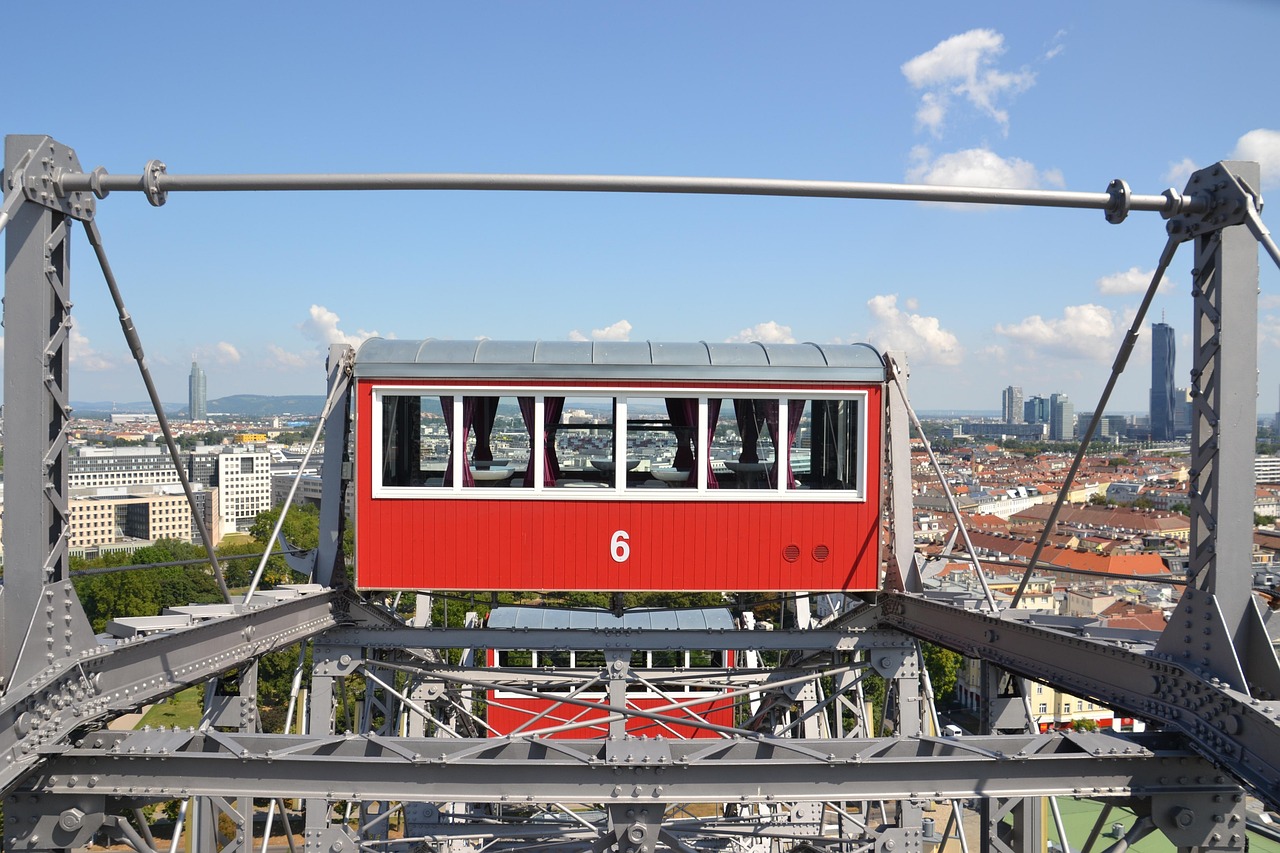 The Reisenrad ferris wheel at Prater Park. Photo / Mike Yardley
The Reisenrad ferris wheel at Prater Park. Photo / Mike Yardley
Another notable feature of my Trafalgar experience was the distinctive accommodation. Vienna was a star specimen, where we stayed at the Imperial Riding School, which is now part of Marriott’s Autograph Collection. Magnificently refreshed as a hotel, Emperor Franz Joseph I established the property as his military equestrian school in the 19th century, close to Belvedere Palace. His regal impact can still be felt in the vaulted ceilings and striking archways that pervade the surviving majestic front building. You’ll discover all manner of nods to its heritage, from the stable-inspired floors to the plethora of apple delights, plucked from the orchard that is in the same spot as the apple trees that Franz Joseph I famously loved. It’s a stirring hotel experience.
Tour Differently. Travelling with Trafalgar means you won’t just see the world – but you’ll experience it with authenticity at the forefront. Tour adventurously, from the must-sees to hidden secrets, and tour locally with those priceless encounters with the locals. Trafalgar’s 10 day Imperial Europe tour has a starting price of $4,422 per person, twin share and includes a savings of up to $600 per person. Valid on select travel dates June, July and August 2025. Subject to availability. Call 0800 484 333, visit www.trafalgar.com, or see your local Travel Agent.
Cathay Pacific is spreading its wings in Europe, launching direct flights to Munich in June and Brussels in August, which will increase its reach into Europe by flying to 11 destinations. Cathay Pacific’s Munich flights will be operated by advanced A350-900s, as they do between Auckland and Hong Kong. The aircraft offer fully flat beds in Business, spacious seats in Premium Economy and comfort in Economy. The cabin air quality is decidedly better on A350s, and you’ll notice how much quieter these big birds are. The seatback entertainment system kept me suitably engaged with a head swirl of premium movie and TV selections, live news channels - all in vivid 4K, plus in-flight WiFi is available. www.cathaypacific.com
Mike Yardley is our resident traveller and can be heard every Saturday with Jack Tame on Newstalk ZB.
Take your Radio, Podcasts and Music with you









